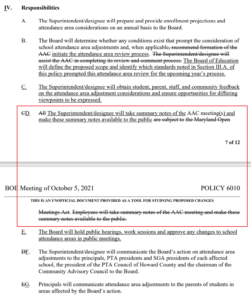Friday • October 22, 2021
Proposed Revisions to HCPSS Policy 6010 – School Attendance Areas (Redistricting): The Good, the Bad and the Unaddressed
By Steven Keller
HCPSS school redistricting is a process that affects thousands of families across Howard County every 2-5 years. The policy that governs this redistricting process, HCPSS Policy 6010, is currently under review by the Board of Education and is due for significant modifications. The draft revised Policy 6010 proposed by Superintendent Martirano can be found here. A summary presentation given at the October 5, 2021 HCPSS Board of Education meeting can be found here.
A prior HoCo Watchdogs post discussed recommended modifications to Policy 6010 that would maximize its effectiveness & efficiency and constructively limit the scope of redistricting. Another prior post discussed concerning recommendations that the Policy 6010 HCPSS public committee had recommended to Superintendent Martirano in January 2021.
Included below is a summary of improvements, new problems and unaddressed issues that exist in the proposed new official draft Policy 6010 that the HCPSS Board of Education is considering for approval.
If you disagree with any of the proposed changes to this policy or feel that further modifications should be included, you are strongly encouraged to sign up to publicly testify at the HCPSS Board of Education meeting on November 2 at 7:00 PM.
You may also email the Board of Education your thoughts on these changes and your recommended revisions by contacting them at boe@hcpss.org.
Summary
Improvements
- Formally establishes in Policy 6010 that the Board may consider exemptions for students who have been redistricted within the last 5 years, students with IEP or 504 plans, and students with one or more parents as active duty military personnel.
- Changes the redistricting process to allow for fresh public testimony after every iteration of polygon moves made to the redistricting plan throughout the process. HCPSS families who get redistricted late in the process will be able to publicly share their concerns with the Board and perhaps influence the Board to make further revisions.
New Problems
- Language is added that institutionalizes “balancing measurable socioeconomic factors across schools” as a formal goal of redistricting.
- Language is removed that states that the Area Attendance Committee (AAC) meetings are subject to the Maryland Open Meetings Act (OMA). No language included to make sure meetings are open to the public or recorded for public record.
- Language is included that states that HCPSS will only release summary notes of AAC meetings instead of full recordings and/or transcripts.
- Target utilization range is established as 90-110% and is set as a condition that triggers the Board to consider attendance area adjustments. The Board will now need to consider redistricting *every year* for the foreseeable future, unless residential development dramatically decreases or new schools magically appear.
Existing Problems Left Unaddressed
- No language is added to firmly establish that “balancing capacity utilization across all schools” is the primary goal of redistricting.
- “Demographic Characteristics of Student Population” (including race/ethnicity, academic performance & test scores, gender, sexual orientation/identity & religion) is still included as a primary/overarching factor for redistricting.
- No language is added to ensure that students in need of an Individualized Education Program (IEP) or 504 plan who have not yet been approved for such a plan will be granted exemption from redistricting. Currently, only students with IEPs & 504 plans already established at the time of that the Board votes to approve a redistricting plan. Students who receive an IEP or 504 plan during that same academic year but after the redistricting vote are typically excluded from the right to remain at their current school.
Detailed Discussion
Improvements
Changes to Section 3. C. 7.










